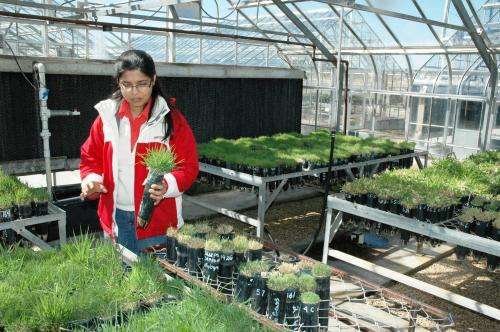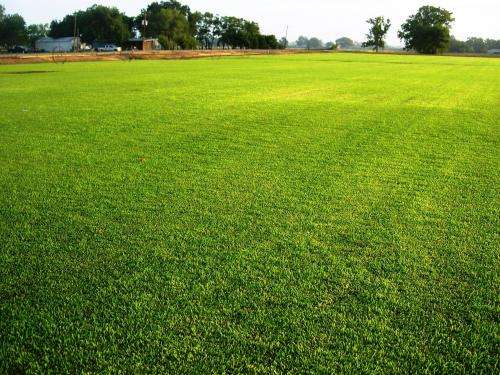New St. Augustine grass hybrid uses less water, offers other advantages

Dwindling water resources caused by drought, extreme temperatures and other environmental factors have made the development of more water-efficient turfgrasses increasingly important for southern landscapes, according to experts at Texas A&M AgriLife Research.
According to national water-use statistics, about one-third of all the water consumed by cities in the southern U.S. is used to irrigate lawns and gardens.
Recently Dr. Ambika Chandra, associate professor of turfgrass breeding and genetics at the center, released a new drought-tolerant St. Augustine grass variety that also resists the major disease and insect pests that commonly attack lawns in the southern U.S.
"This new variety is the first hybrid of St. Augustine grass produced by our advanced breeding techniques to be released for the commercial turfgrass industry," Chandra said.
At the Texas A&M AgriLife Research and Extension Center in Dallas, home of the AgriLife turfgrass breeding program, scientists are continually developing and testing new turfgrass lines that require less water and have increased drought, disease, insect, shade and cold tolerance—characteristics preferred by homeowners and landscape professionals alike.
Over the years, the program has generated thousands of new St. Augustine grass lines, as well as other turfgrass lines, Chandra said. These lines are evaluated at different locations over a period of years to identify the few that have superior characteristics.

She said the new variety, currently identified by its experimental name, DALSA 0605, has shade tolerance and deep roots comparable to Floratram, a successful St. Augustine grass collaboratively developed by Texas A&M University and the University of Florida.
"So far, DALSA 0605 has shown excellent response to drought stress in the field. Much of this is due to its long roots that allow it to penetrate deeper into the soil to obtain moisture where other varieties cannot," Chandra said. "It also does well during soil dry-down after exposure to extended periods without water, as well as in the recovery phase once water is reintroduced."
Development of DALSA 0605 was partially funded by the Turfgrass Producers of Texas, with field testing of the new turfgrass initiated in 2004 at the Dallas center. She said DALSA 0605 has also shown wide-range adaptation through additional field testing in Oklahoma, Georgia, North Carolina and Florida, as part of a collaborative project funded by U.S. Department of Agriculture.
"DALSA 0605 will most likely be commercially available in 2015," she said.
Chandra said DALSA 0605 and many other turfgrass varieties will be on display during the upcoming Turfgrass, Landscape and Irrigation Expo May 16-17 at the center, located at 17360 Coit Road.
"This statewide event is designed to highlight new drought tolerant turfgrass varieties from the Texas A&M AgriLife breeding program, innovations in irrigation technology and new landscape best management practices," Chandra said. "The event will help industry professionals and others understand how to select and maintain turfgrasses in order to cope with harsh environmental conditions and water restrictions."
She said DALSA 0605 would be of interest to both professionals, for whom the May 16 portion of the expo is designed, and homeowners, who are the target audience for the May 17 portion.
"Field day attendees will be able to see and learn about all five different species of turfgrasses – Bermuda grass, zoysia grass, St. Augustine grass, Seashore paspalum and hybrid bluegrass – being evaluated at the center, along with commercially available varieties," Chandra said.
She said the expo will include field tours on topics including selection and management; irrigation scheduling, management and subsurface drip; pest and disease management; and nutrient management and the environment. There also will be educational demonstrations, and hands-on demonstrations of new technologies to reduce water use in urban areas.
Provided by Texas A&M University



















